
The Health Sciences and Human Services Library Historical Collections’ strives to provide broad access to our diverse collections both in person and digitally. Materials in our collections appear as they originally were published or created and may contain offensive or inappropriate language or images and may be offensive to users. The University of Maryland, Baltimore does not endorse the views expressed in these materials. Materials should be viewed in the context in which they were created.
The holiday and winter seasons have common ingredients, usually with bold, warming flavors. The holiday bread, cookie, and cake recipes call for spices and flavorings like nutmeg, ginger, vanilla, and clove or nuts like walnuts and almonds. Historically however, these ingredients were prescribed for a variety of ailments in botanicals and herbals.
Like the post highlighting medicinal uses for winter fruits, this post will look at common holiday spices, flavorings, and nuts found in William Woodville’s Medical Botany and Robert Bentley’s Medicinal Plants. Both men were botanists from England and both works are found in the HSHSL’s Historical Collections. Woodville’s volumes were published in the 1790s, while Bentley’s volumes were published nearly a decade later in 1880 and are digitized in the UMB Digital Archive. Read on to see how these comforting holiday flavors were once used for very different purposes.
Common Holiday Spices
llicium anisatum
Common name: Star-Anise or Skimmi in Japan
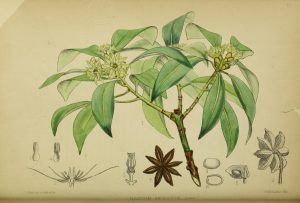 Illicium anisatum is a small tree that blossoms from January to April and is native to Japan. The tree was cultivated in China and introduced in England in 1842. The fruit, called “star-anise,” has eight or nine points forming a star shape. The fruit is dried to sell and has a pleasant aromatic odor; the taste is a mixture of fennel and anise or black licorice. An oil, called oil of anise or oleum badiani, is produced from the tree.
Illicium anisatum is a small tree that blossoms from January to April and is native to Japan. The tree was cultivated in China and introduced in England in 1842. The fruit, called “star-anise,” has eight or nine points forming a star shape. The fruit is dried to sell and has a pleasant aromatic odor; the taste is a mixture of fennel and anise or black licorice. An oil, called oil of anise or oleum badiani, is produced from the tree.
The oil was used as an expectorant, used in lozenges for coughs. Star-anise was prescribed to help with stomach gases, to promote milk secretion in lactating mothers, to help children with colic, and as a cathartic. Additionally, star-anise was used in medicine for cattle. As it is used today, the oil and fruit from Illicium anisatum were also used for flavor to hide other medicines or in spirits.
Myristica fragrans
Common name: Nutmeg
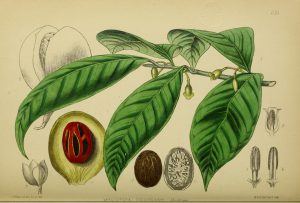 Myristica fragrans is a small evergreen tree that produces fruit the size of a small pear. The seed of the fruit is known as “nutmeg.” The tree was native to Moluccas (Maluku Islands) and Indian Islands, Amboyna Island, Bouro (Portugal), New Guinea, the Philippines, Bencoolen (British East India Company), Penang Island, Singapore, Mauirtius, West Indies, and South America. The tree was introduced to Europe in 1795. The fruit harvest occurred from September to December as well as April to June.
Myristica fragrans is a small evergreen tree that produces fruit the size of a small pear. The seed of the fruit is known as “nutmeg.” The tree was native to Moluccas (Maluku Islands) and Indian Islands, Amboyna Island, Bouro (Portugal), New Guinea, the Philippines, Bencoolen (British East India Company), Penang Island, Singapore, Mauirtius, West Indies, and South America. The tree was introduced to Europe in 1795. The fruit harvest occurred from September to December as well as April to June.
Nutmeg has a strong, pleasant aroma and a warm, bitter taste. It was used medicinally as a stimulant and for stomach issues and was used to treat mild cases of diarrhea, flatulent colic, and dyspepsia. In large doses it was found to be a narcotic. It was most used to cover the bad taste of other medicines or as a condiment.
Caryophyllus aromaticus
Common name: Clove Tree
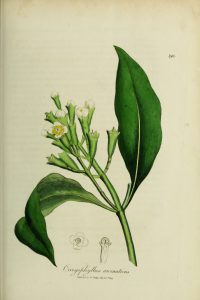 Caryophyllus aromaticus is a small tree native of the East Indies, Moluccas (Maluku Islands), and New Guinea. According to Woodville, Dutch traders were rumored to have clove trees outside of their jurisdiction destroyed to hold a monopoly on the clove trade. This confined the trees to the Island of Ternate controlled by the Dutch. The Dutch monopoly ended in 1770 when clove and nutmeg trees were brought to the Isle of France, Bourbon, and Seickelles.
Caryophyllus aromaticus is a small tree native of the East Indies, Moluccas (Maluku Islands), and New Guinea. According to Woodville, Dutch traders were rumored to have clove trees outside of their jurisdiction destroyed to hold a monopoly on the clove trade. This confined the trees to the Island of Ternate controlled by the Dutch. The Dutch monopoly ended in 1770 when clove and nutmeg trees were brought to the Isle of France, Bourbon, and Seickelles.
Clove is aromatic with a hot and spicey flavor. It was traditionally preserved by immersing the clove in boiling water, fumigating it, and then exposing it to the sun to dry out. Clove is a powerful stimulant for muscular fibres. It was used in some cases to treat atonic gout.
Rosmarinus officinalis
Common name: Rosemary
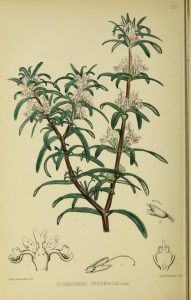 Rosmarinus officinalis is a small shrub native to the Mediterranean. The shrub was also commonly found near the coast in warm, dry, hilly areas in Spain and Asia Minor and in Northern Africa, reaching to Madeira and the Canary Islands. It flowers in April and May. Rosemary is aromatic and has a warm, bitter taste. The flavor and scent are strongest when the plant is fresh; both are impaired when the plant is dried.
Rosmarinus officinalis is a small shrub native to the Mediterranean. The shrub was also commonly found near the coast in warm, dry, hilly areas in Spain and Asia Minor and in Northern Africa, reaching to Madeira and the Canary Islands. It flowers in April and May. Rosemary is aromatic and has a warm, bitter taste. The flavor and scent are strongest when the plant is fresh; both are impaired when the plant is dried.
Oleum Rosmarini or “oil of rosemary” was produced from the plant, with similar scents and tastes and was commonly used externally with other substances to stimulate the growth of hair or in lotions for its pleasant scent. Rosemary has stimulant and carminative properties. The plant was prescribed to stimulate or increase menstruation. The leaves could be used as a tea and was prescribed for hypochondriacal people and dyspeptics. Finally, rosemary was given to help with hysteria and nervous headaches.
Common Holiday Flavors
Zingiber officinale
Common name: Ginger
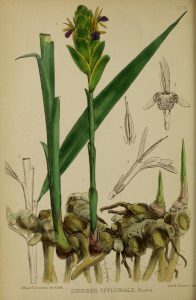 Zingiber officinale is a perennial herb. Ginger has a large underground stem, known as a rhizome. It is tough, pale yellow, covered with pale silvery-brown skin, with persistent roundish joints and numerous roots. Ginger is native to tropical Asia and abundant in the West Indies. It was exported to Europe sometime in the seventeenth century.
Zingiber officinale is a perennial herb. Ginger has a large underground stem, known as a rhizome. It is tough, pale yellow, covered with pale silvery-brown skin, with persistent roundish joints and numerous roots. Ginger is native to tropical Asia and abundant in the West Indies. It was exported to Europe sometime in the seventeenth century.
There are varieties of ginger depending on where it is grown: Jamaica, Cochin, Bengal, and Africa. Ginger is prescribed in two forms in the British Pharmacopoeia and Pharmacopoeia of India: coated or unscraped and uncoated or scraped. When used internally, ginger was a stimulant and used in the treatment of stomach pain. Ginger was also prescribed for external use to dilate capillaries and improve circulation, sometimes to relieve headaches and toothaches. Ginger was also prescribed for atonic dyspepsia and as an addition to other medicines to correct stomach pain.
Vanilla planifolia
Common name: Vanilla or Baynilla (in Mexico)
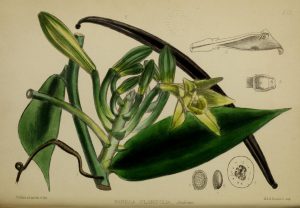 Vanilla planifolia is a succulent. It is a dark green perennial climber that grows from five to six inches long. The plant flowers in April and May and is related to orchids. Vanilla is native to southeast Mexico, Vera Cruz, Mauritius, Bourbon, Madagascar, and Java. It was introduced to England sometime around 1800. The plant produces pods, which were traditionally collected before they were fully ripe, dried in the shade, and then covered in a coating of oil.
Vanilla planifolia is a succulent. It is a dark green perennial climber that grows from five to six inches long. The plant flowers in April and May and is related to orchids. Vanilla is native to southeast Mexico, Vera Cruz, Mauritius, Bourbon, Madagascar, and Java. It was introduced to England sometime around 1800. The plant produces pods, which were traditionally collected before they were fully ripe, dried in the shade, and then covered in a coating of oil.
Vanilla has a strong, aromatic odor and warm, sweet taste. It was used as an aromatic stimulant and was regarded as an aphrodisiac. Vanilla was prescribed as a remedy for hysteria, low fevers, and impotency. More regularly vanilla was used for its flavor in lozenges and medical mixtures.
Common Holiday Nuts
Amygdalus communis
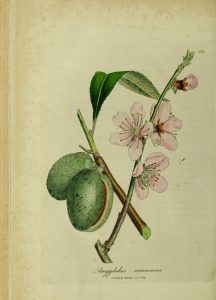 Common name: Almond Tree
Common name: Almond Tree
Amygdalus communis is a tree that grows to about twelve to sixteen feet tall with large pale red flowers. The tree flowers in March and April and is a native of Barbary. It was cultivated in England in 1570.
The medicinal qualities of the Almond Tree were discussed as far back as antiquity being mentioned by both Theophrastus and Hippocrates. Almond oil was used internally as a laxative, to sooth coughs and horseness, and for kidney pains. Externally the oil was used to relieve tension and muscle pain. Almond emulsions were also prescribed for inflammatory disorders. The London College prescribed the addition of Almond to gum Arabic to make it easier to use to relieve inflammation caused by colds.
Juglans regia
Common name: Common Walnut Tree
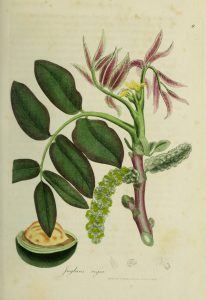 Juglans regia is a large tree that flowers in April and May. The fruit of the tree ripens at the end of September. The walnut tree is native to Persia but was cultivated in England during Woodville’s time.
Juglans regia is a large tree that flowers in April and May. The fruit of the tree ripens at the end of September. The walnut tree is native to Persia but was cultivated in England during Woodville’s time.
Unripe walnuts are bitter and in this form were used as a pickle and as a laxative. The London College prescribed walnuts to kill parasitic worms. Walnuts were also used to treat mouth ulcers and sore throats.
William Woodville’s and Robert Bentley’s volumes are found in the Pharmacy Collection in the HSHSL’s Historical Collections. This collection contains influential pharmacy and medical texts, as well as dispensatories, pharmacopoeias, botanicals, and herbals from around the world. The volumes in the collection date from the seventeenth to the twentieth centuries. Many, including Robert Bentley’s text are available through the UMB Digital Archive. Additionally, images from Woodville’s Medical Botany were used in the Library’s 2020 Coloring Book.
Happy Holidays from Historical Collections!

